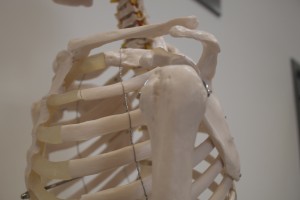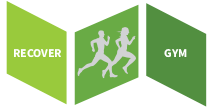Broken collar bone
Rehab training of the injury
Rehab 1 – Rehab 2 – Rehab 3 – Rehab 4
Focus on training the rest of the body, so you do not lose your current mobility, stability and strength. Then find out what you can do from workout programs and work out according to the level you have. Exercise of the rest of the body accelerates healing of your injury, among other things due to increased nerve activity and circulation.

Description of broken collar bone
A broken collar bone, also called clavicular fracture, is a notch, crack, break or complete separation of the collar bone. Of all types of fractures around the shoulder, this is the most frequent, and most often the fracture is located in the middle of the bone. The damage is caused by trauma primarily in contact sports or in the case of fall injuries where a person lands on an out stretched arm. The injury most commonly occurs in skiing, cycling and running on roller skates.
IMPORTANT! – One should be aware that a broken collar bone can cause a punctured lung. Therefore, be aware of the symptoms such as acute respiratory distress, shortness of breath in activity, and if there is also pain while breathing.
Symptoms of broken collar bone
- Distinct pain at the collar bone after trauma.
- Direct (on site) and indirectly (pressure from shoulder / upper arm area) soreness on the line of fracture.
- Pain when the upper arm is moved as the clavicle is rotated and the fracture unevenly scratches against its two separated parts.
- Often a deformity is seen as the bone tip from the fracture can be seen and felt under the skin (open fracture).
Undersøgelser af brækket kraveben
- Analysis / Inspection / Palpation / ROM, Visual and Physical Comparison with opposite side.
- Direct and indirect soreness.
- Tuning fork (127-128hz) test.
- Pain at the fracture line when moving.
Treatment of broken collar bone
The injury should be checked by a doctor. The doctor can make sure that the large nerves of the arm around the injury are not damaged while also excluding lung and rib injury. X-ray examination can determine final diagnosis. It is rare that surgery is required.
Immobilized period:
- Immobilize the injury in the most painless position.
- Lock if necessary. arm with elastic bandage.
- 8-piece sling that prevents the shoulder from moving forward for 8 weeks in adults and 3 weeks in children.
- Then 5-7 days immobile.
- Exercise of the rest of the body while the arm is immobilized, strength training, cycling on stationary bike etc.
Rehab period:
- Rehab of the clavicle.
- Active rest.
- Kinesiology tape

Social Medier